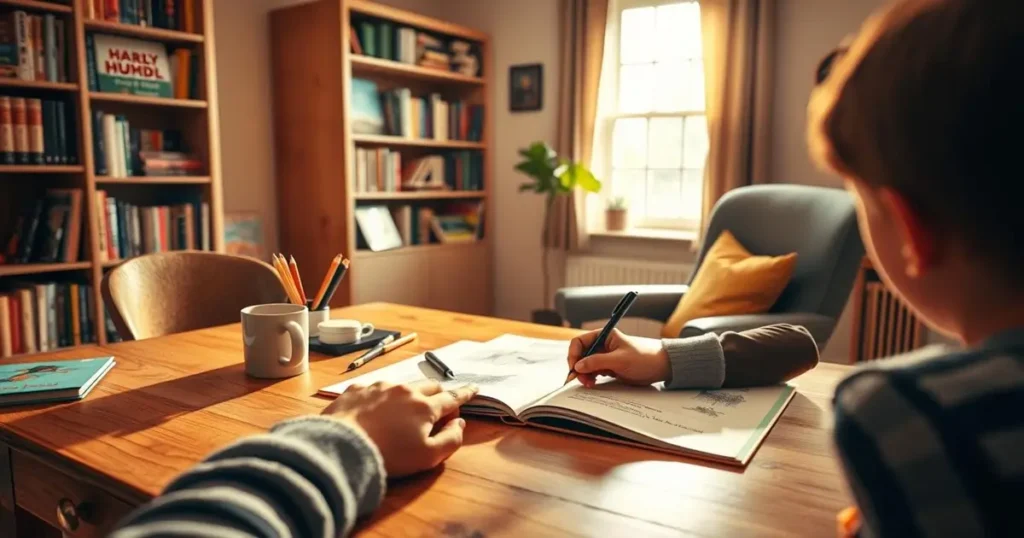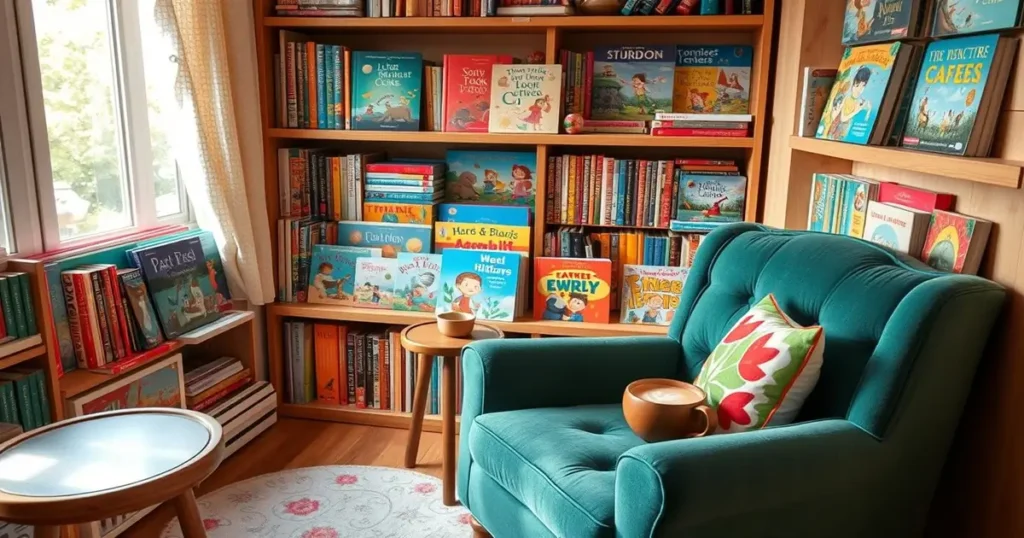Did you know that 85% of bestselling children’s books follow a structured framework? This statistic highlights the importance of a clear, organized approach when crafting stories for young readers. Writing for children isn’t just about creativity—it’s about understanding their world and delivering engaging, age-appropriate content.
Creating a successful children book involves more than just a good idea. It requires attention to detail, from character development to integrating illustrations. Tools like Squibler’s AI book-writing templates can simplify formatting, allowing you to focus on the story itself.

We’ll explore a proven 9-step framework that balances creative freedom with strategic structure. Whether you’re a first-time writer or an experienced author, these steps will guide you from concept to polished manuscript. Let’s dive into the mechanics of crafting a story that resonates with young minds.
Table of Contents
Understanding the Essentials of Children’s Literature
The world of children literature is shaped by creativity, simplicity, and age-specific storytelling. Crafting a story that captivates young readers requires a deep understanding of their developmental stages and preferences. From rhythmic language to visual storytelling, every element plays a crucial role in engaging kids.
Key Features That Captivate Young Readers
Young readers are drawn to stories that combine rhythmic language, vivid visuals, and simple morals. For example, Dr. Seuss’s controlled vocabulary formula ensures that every word resonates with the target age group. Repetition, as seen in Robert Munsch’s works, enhances engagement and helps kids retain the story.
Visual storytelling is equally important. Picture books often follow the 30% rule, where 30% of the content is text and 70% is visuals. This balance keeps kids hooked while supporting their reading comprehension.
Why Age-Appropriate Content Matters
Creating age-appropriate content is essential for fostering literacy and engagement. For toddlers, attention spans range from 2-5 minutes, making short, rhythmic stories ideal. Middle-grade readers, on the other hand, can focus for 30+ minutes, allowing for more complex plots and character development.
Educators emphasize the importance of age-specific vocabulary. According to literacy statistics, 68% of educators prioritize this aspect to ensure kids can understand and enjoy the story. Word count benchmarks also vary by age, with early readers typically engaging with 500-1,000 words.
By understanding these essentials, we can craft stories that not only entertain but also support the cognitive and emotional growth of young readers.
How to Write a Children’s Book: 9 Powerful Steps to Create a Bestselling Story
Crafting a story for young readers starts with knowing your audience. Understanding their developmental stage and interests is the foundation of any successful children book. Let’s break down the essential steps to create a story that resonates.
Define Your Target Age Group and Category
Before you begin, identify the age group you’re writing for. Board books (0-3) require simple, rhythmic language, while middle-grade readers (8-12) can handle more complex plots. According to 48 Hour Books, board books typically have 32 pages, while chapter books for 5-9-year-olds average 2,500 words.

The Society of Children’s Book Writers and Illustrators (SCBWI) provides clear guidelines for each category. Misjudging the age group is a common mistake, with 72% of rejected manuscripts failing to align with their intended audience.
Craft Relatable Characters Kids Will Love
Memorable characters are the heart of any story. Use a 5-question personality profile to define their goals, fears, and quirks. For example, Mo Willems’ Pigeon character resonates because of its relatable emotions and playful personality.
Here’s a quick checklist to ensure your characters connect with young readers:
- What do they want? (Goals)
- What scares them? (Fears)
- What makes them unique? (Quirks)
- How do they solve problems? (Resourcefulness)
- Why should kids care? (Relatability)
Build a Simple Yet Engaging Plot
Young readers thrive on straightforward yet captivating stories. Use a three-act framework to structure your plot. Start with a clear conflict, build tension, and resolve it in a satisfying way. For example, “The Day the Crayons Quit” masters simplicity by focusing on a single, relatable idea.
Conflict-building exercises like “What’s the worst that could happen?” can help you create engaging scenarios. Remember, word count matters. Tools like Squibler’s AI can help reduce a 1,200-word draft to 800 words without losing impact.
| Age Group | Word Count | Page Length |
|---|---|---|
| 0-3 (Board Books) | 100-300 | 24-32 pages |
| 5-9 (Chapter Books) | 2,000-2,500 | 48-64 pages |
| 8-12 (Middle Grade) | 20,000-40,000 | 150-250 pages |
By focusing on these things, you’ll create a story that not only entertains but also supports the cognitive and emotional growth of young readers. Whether you’re writing for toddlers or tweens, these strategies will help you work smarter, not harder.
Choosing the Right Format for Your Children’s Book
Selecting the right format is a critical step in bringing your story to life. The format you choose impacts readability, engagement, and even production costs. Whether you’re crafting a vibrant picture book or a detailed chapter book, understanding the options ensures your work resonates with young readers.

Picture Books vs. Chapter Books: What’s Best for Your Story?
Picture books and chapter books serve different purposes. Picture books, typically 32 pages long, rely heavily on visuals to tell the story. They’re ideal for younger children who enjoy colorful images and simple narratives. Chapter books, on the other hand, are text-heavy and cater to older kids who can handle more complex plots.
Here’s a quick comparison:
- Picture Books: 8.5″x11″ trim size, 30% text, 70% visuals.
- Chapter Books: 5″x8″ trim size, longer word counts, divided into chapters.
Word Count and Page Length Guidelines by Age
Understanding age-specific guidelines helps you tailor your story effectively. For example, board books for toddlers should have 100-300 words, while middle-grade books can range from 20,000 to 40,000 words. Font size also matters—24pt for toddlers and 14pt for middle-grade readers.
Here’s a detailed breakdown:
| Age Group | Word Count | Page Length |
|---|---|---|
| 0-3 (Board Books) | 100-300 | 24-32 pages |
| 5-9 (Chapter Books) | 2,000-2,500 | 48-64 pages |
| 8-12 (Middle Grade) | 20,000-40,000 | 150-250 pages |
By aligning your format with these standards, you’ll create a book that’s both engaging and age-appropriate. Make sure to consider your audience, budget, and story type when making your decision.
The Power of Illustrations in Children’s Books
Illustrations play a pivotal role in making children’s books unforgettable. They bring stories to life, capturing the imagination of young readers and enhancing their understanding of the narrative. A well-illustrated book can turn a simple story into a visual masterpiece, making it more engaging and memorable.
Collaborating with an Illustrator
Working with a professional illustrator can elevate your manuscript to new heights. It’s essential to establish clear communication and define expectations early in the process. Here are some key points to consider:
- Budget: Professional illustrations can range from $2,000 to $15,000, depending on the complexity and scope of the project.
- Contract Essentials: Ensure the agreement covers rights, royalties, and revision limits to avoid misunderstandings.
- Resources: Platforms like the SCBWI Illustrator Gallery connect authors with vetted professionals.
DIY Illustration Tips for Authors on a Budget
If hiring an illustrator isn’t feasible, there are ways to create your own pictures. Tools like Procreate ($9.99) and Adobe Illustrator ($20.99/month) offer professional-grade features for self-illustration. Here’s a quick comparison:
| Software | Cost | Best For |
|---|---|---|
| Procreate | $9.99 | Beginners, iPad users |
| Adobe Illustrator | $20.99/month | Advanced users, vector art |
For those new to writing and illustrating, Canva offers an easy-to-use platform for creating and converting designs to PDF. Additionally, stock image sources like Shutterstock and Creative Market provide affordable options for high-quality visuals.
Understanding color psychology can also enhance your work. Bright primary colors, as used by Eric Carle, are particularly effective in capturing the attention of younger children. By combining these tips and tools, you can create a visually stunning book that resonates with your audience.
Writing Techniques That Keep Kids Hooked
Engaging young readers requires mastering specific storytelling techniques. From rhythmic language to playful humor, every element plays a role in capturing their attention. Let’s explore how to craft a story that keeps kids coming back for more.
Using Rhyme and Repetition Effectively
Rhyme and repetition are powerful tools in writing children’s stories. Dr. Seuss’s “The Cat in the Hat” uses only 236 unique words, proving that simplicity can be impactful. Educators prefer anapestic tetrameter for early readers, as it creates a natural rhythm that’s easy to follow.
Here are some techniques to enhance your language:
- Rhyme Schemes: Use couplets or ABAB patterns for consistency.
- Meter Tools: Online syllable counters help maintain rhythm.
- Repetition: Repeating key phrases reinforces the story’s message.
Remember, 63% of agents reject forced rhymes that lack meter consistency. Keep it natural and engaging.
The Role of Humor and Playful Language
Humor is a surefire way to keep kids entertained. Books with humor elements see a 42% higher re-read rate, making it a valuable addition to your writing. Playful language, such as onomatopoeia and alliteration, adds a fun layer to the narrative.
Here’s how to incorporate humor effectively:
- Joke Formulas: Use the rule of three (setup, anticipation, punchline).
- Sound Words: Include kid-approved onomatopoeia like “buzz” or “splat.”
- Visual Humor: Take inspiration from Dav Pilkey’s “Captain Underpants” series.
Case studies like Julia Donaldson’s “The Gruffalo” show how rhythm and humor can create a lasting impression. By blending these techniques, you’ll craft a story that resonates with young characters.
| Technique | Example | Impact |
|---|---|---|
| Rhyme | Dr. Seuss’s “Green Eggs and Ham” | Enhances memorability |
| Humor | Dav Pilkey’s “Dog Man” | Increases re-read rates |
| Repetition | Robert Munsch’s “Love You Forever” | Builds emotional connection |
By mastering these techniques, you’ll create a story that not only entertains but also leaves a lasting impact on young minds.
Editing and Polishing Your Manuscript
Polishing your manuscript is the final step to creating a story that truly shines. Editing ensures your book is clear, engaging, and ready for young readers. Whether you’re self-publishing or submitting to an editor, this process is essential for success.
According to industry statistics, manuscripts with professional editing have a 73% higher acceptance rate. Tools like Grammarly catch 85% of syntax errors, making them invaluable for refining your work. Let’s explore how to avoid common pitfalls and test your story effectively.
Common Mistakes to Avoid in Children’s Books
Even the best stories can fall short without proper editing. Here are some frequent errors to watch out for:
- Overused Tropes: Agents often reject clichés like talking animals without unique twists.
- Pacing Issues: Use a 12-point rubric to check clarity and flow.
- Cultural Insensitivity: Conduct a diversity audit to ensure inclusivity.
For example, the editors of Harry Potter tightened the first book by removing unnecessary subplots. This focus on clarity helped the story resonate with its target age group.
How to Test Your Story with Young Readers
Testing your book with its intended audience is crucial. Here’s how to gather valuable feedback:
- Beta Readers: Use age-specific feedback forms to understand what kids enjoy.
- Read-Aloud Timing: Aim for 12-15 minutes for bedtime stories.
- Page Flip Test: Ensure picture books flow seamlessly from one page to the next.
Case studies show that stories tested with young children are more likely to succeed. By incorporating their feedback, you can refine your manuscript into a story that truly connects.
Your Journey to Becoming a Published Children’s Author
Embarking on the path to publishing a children’s book is both exciting and challenging. Whether you choose traditional or self-publishing, each route has its unique benefits. Traditional publishing offers prestige but has a 2% acceptance rate, while self-publishing gives you full creative control.
Costs are a key consideration. Professional-grade self-publishing averages $2,500, covering editing, design, and marketing. Platforms like Amazon KDP and IngramSpark provide affordable options, with print costs as low as $5 per book. Don’t forget essential details like ISBNs, which start at $125 for a single purchase.
Marketing is crucial for success. Plan school visits, book fairs, and social media campaigns to reach your audience. Case studies like “The Wonky Donkey” show how effective strategies can lead to publishing success. Resources like SCBWI conferences and Publishers Marketplace subscriptions can also guide your journey.
With dedication and the right tools, your manuscript can become a beloved book for young readers. Keep your end goal in mind, and embrace the process with patience and perseverance.